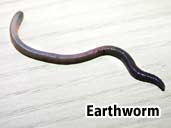Earthworm Care Sheet
Name: Earthworm (This species is the common earthworm in the UK, but is sometimes referred to as a Nightcrawler in Canada and America). Scientific name: Lumbricus terrestris Lifespan: Earthworms are long lived and can reach up to seven years of age. The benefit of Earthworms as a foodEarthworms are a very nutritious prey item and are suitable for a large number of reptiles and amphibians. They are packed with vitamins (including vitamins A and E) and can make up 50-60% of an certain reptiles and amphibian’s diet. They come in a variety of sizes depending on the life stage they are at, but can also be chopped for consumption by smaller reptiles and amphibians. They are easily obtainable and relatively cheap from online sources, but are also collectable from fertiliser-free gardens and woodland. (If you cannot guarantee an area is fertiliser and pesticide free then do not collect wild earthworms, as chemicals can pass on to your reptiles and amphibians through ingestion). Earthworm HousingA small culture can be started quite easily in any container that offers good ventilation, drainage and dark sides. A plastic bin, bucket or RUB (really useful box) can be used for this purpose. Drill small holes in the bottom of the tub for drainage, but ensure that the holes remain small to prevent escapes. Line the bottom with a few pebbles or sand, then fill with either a fertiliser-free soil, peat or a coco-fibre type substrate like Eco-Earth. It is important that this soil is kept slightly damp, so water the substrate well with collected rain water if possible, and then add your starter culture of worms. Approximately 100 + worms is recommended, but not vital if you do not expect to use a great deal of worms regularly. Add food to the bin and then cover the top with sphagnum moss, card or fabric to prevent pests being attracted, but still allow the tub to be ventilated. Place in a cool, dark place, preferably outside to replicate the conditions they would be accustomed to. Earthworm FeedingEarthworms with eat a wide variety of vegetable scraps and are useful for composting some of our kitchen waste. Potato peelings, banana skins, and oatmeal are all good food items to offer them, but they will usually eat any vegetable scraps and some fruits (avoid citrus fruits). Flaked fish food can be used and broken egg shells are a good item to add calcium value to your earthworms. They will also eat garden waste like leaf litter and grass clippings. Feed only when all the previous food offerings have been eaten to avoid a build up of uneaten items and offer small pieces rather than large ones to speed up the rate at which they break down the food substances. Burying the food items below the surface of the soil is also advised, as earthworms usually stay away from the surface during the day and to discourage the attraction of pests. Earthworm TemperatureEarthworms do not tolerate heat very well, so it is advisable to keep your culture outside if possible. If you have collected your earthworms from the garden, then this is the temperature they will be accustomed to. If it is not possible to keep them outside, place them in a cool, dark area of the home where temperatures do not exceed a maximum of 28°C (82°F), as earthworms will usually die at temperatures exceeding this. 15-18°C (59-64°F) is the optimum temperature, so if you live in a climate where keeping them at this low temperature is difficult, then a refrigerator should be considered (although this may slow down the reproductive rate). Earthworm BreedingThe downside to keeping an earthworm culture is that they are quite slow to reproduce and it can take up to about 8 -12 months before you benefit from the breeding of your earthworms. Since earthworms are hermaphrodites, you can expect each adult worm to produce around 20-30 offspring a year, but eggs are slow to hatch, needing around 100 days before the young ones leave the case. To supplement your culture in the mean time, more earthworms can be added at regular intervals. This will keep you with a regular food source for your specific reptile or amphibians that will be enriched in good soil and fed appropriately. Other Useful Information about EarthwormWhen preparing your earthworms for feeding to your amphibian, a small spade may be useful (a child’s beach spade is perfect). Dig gently below the surface to unearth your earthworms for collection. Rinse with water to remove any surface soil before offering the earthworm to your pet.
|
|

